Any electronic unit of the car is connected to a diagnostic bus - a digital line that allows the on-board electronics to interact with diagnostic equipment. Here lies the first problem: although theoretically there is single standard OBD-II, which standardizes the method of communication with the ECU and the type of connector, applies only to injection systems. “Reach” the blocksABS,SRS and so on via protocolOBD-II is not possible. But even in injection systems, company-specific error codes and status data encoding are often used: when diagnosing a completely serviceable car with a program that is not suitable for its ECU, you can see data that is incompatible with reality.
What tasks does a diagnostic scanner perform? There are many more of them than is commonly thought.
- Reading current and saved data. The most primitive devices are capable of reading only saved and current errors, but for diagnostic purposes such things are practically useless: without the ability to correctly read current data (air flow, throttle opening degree, lambda probe voltages), the device is more of a toy than a real tool.
- Testing of actuators. Depending on the degree of integration of the on-board electronics, you can check the serviceability of many electromechanical components: from turning on the fuel pump to testing the wipers (if the motor is controlled by a controller, of course).
- Adaptation of sensors and actuators. A number of complex components require forced coordination with the ECU: setting the zero position of the throttle servo drive, setting the debit rate of piezo injectors on Common Rail diesel engines, and so on.
- Changing the configuration. Most units are universal for the entire family of cars, and they are configured to match a specific configuration (for example, the number and location of airbags is specified in the airbag controller). The simplest examples of reconfiguration are changing the instrument panel language, activating the on-board computer, disabling faulty airbags.
In the ranking of the best, we tried to take into account both affordable simple car scanners, usually purchased by car owners for their own use, and professional equipment. The only exception is dealer scanners designed for specific car brands: the price of such complexes is several hundred thousand rubles, and dealer equipment is not widely sold - you can only find cheap Chinese clones.
The most important thing in diagnosing a car is not the “sophistication” of the device, but the professionalism of the person using it. Therefore, when buying a diagnostic scanner for personal use, you should think about whether this will be a waste of money, and whether it would be better to contact a real diagnostician?
Gone are the days when printed text (let's say from a magazine), in order to convert it into an electronic format (Word document), sat for hours (if not days, depending on the volume of the text) and manually typed it. The scanner, like almost any electronics today, has become affordable. What is a scanner, you ask, and how will it make life easier or more satisfying when working with electronic documents and not only with them (photos, graphics and everything that can be scanned on a flat surface - let’s say a sheet of paper, i.e. everything that is depicted on it)? We will try to enlighten you on this.
Purposes of using the scanner
So for what purpose is a scanner needed? Let's try to list what he is capable of.Firstly, this is, of course, scanning documents for their further editing in electronic format. You don't have time to type new text or edit the old one. Scanner ( good scanner) can save a lot of time (so, in turn, a bad scanner can take away this time).
Secondly, regular scanning of documents for archiving and storage on a hard drive, since paper can be lost or damaged. Imagine that suddenly management orders you to convert the entire archive of documents into electronic form and store it on your hard drive. In this case, a scanner will come to your aid.
Thirdly, photographic material (now with such a function in some scanners as scanning photo slides and 35 mm film). And subsequently, you can do whatever you want with the photos - just archive them on your hard drive, or edit them in Photoshop (improve quality, eliminate photo defects, etc.). This function will immortalize your memories in photos, and simply your favorite photographs and slides (camera film) that you never had time to print.
Fourthly, the scanner can be used as a copier. That is, if your computer is connected to a printer, then the scanned image can be sent immediately to the printer when certain settings the scanner itself. A very convenient option. Plus to your printer, which together gives a full-fledged copier. Convenient, right?
These are, of course, the main functions of the scanner. So what criteria should we, ordinary buyers, use to choose a scanner? Just appearance you won't get by. Let's, together with MirSovetov, try to understand the characteristics that ensure the quality of its work, and according to which you need to choose a scanner.
Original Size
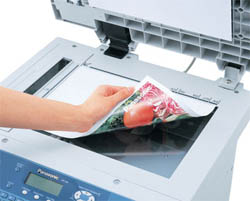 Let's start with the format (scanned image format) or scan area. The standard common format is A4 format - a sheet measuring 29.7 cm in length and 21 cm in width (the scanning area is usually indicated as 21.6x29.7). If your scanner supports this format, which means you can freely (in full size) place a sheet of maximum A4 format on the glass surface. But there are scanners (rare, of course) that support the A3 format - this is a sheet measuring 42 cm in length and 29.7 cm in width - the so-called double A4 format. Today, in principle, there should be no problems with the A4 format, since scanner manufacturers focus on this format. A scanner of A3 and larger formats (and for ease of use it is better to purchase a multifunctional device - a copier-printer-scanner) is not common on the scanner market, but a sophisticated consumer for a six-figure sum will be able to purchase such a copy and easily scan text media of impressive or non-standard sizes.
Let's start with the format (scanned image format) or scan area. The standard common format is A4 format - a sheet measuring 29.7 cm in length and 21 cm in width (the scanning area is usually indicated as 21.6x29.7). If your scanner supports this format, which means you can freely (in full size) place a sheet of maximum A4 format on the glass surface. But there are scanners (rare, of course) that support the A3 format - this is a sheet measuring 42 cm in length and 29.7 cm in width - the so-called double A4 format. Today, in principle, there should be no problems with the A4 format, since scanner manufacturers focus on this format. A scanner of A3 and larger formats (and for ease of use it is better to purchase a multifunctional device - a copier-printer-scanner) is not common on the scanner market, but a sophisticated consumer for a six-figure sum will be able to purchase such a copy and easily scan text media of impressive or non-standard sizes. Optical resolution
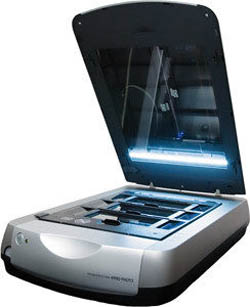 Any image consists of many tiny dots, each dot is one pixel. Optical resolution is the pixels of the image that will be scanned (will be visible later). The optical resolution of the scanner is a very important indicator. It is on this indicator that the picture depends - its quality, detailing, clarity. In the characteristics of the scanner, this indicator is indicated as follows, for example - 4800x9600. In addition to optical resolution, the scanner's characteristics also indicate interpolated resolution. But it has several times greater significance. Let's figure out what these numbers mean.
Any image consists of many tiny dots, each dot is one pixel. Optical resolution is the pixels of the image that will be scanned (will be visible later). The optical resolution of the scanner is a very important indicator. It is on this indicator that the picture depends - its quality, detailing, clarity. In the characteristics of the scanner, this indicator is indicated as follows, for example - 4800x9600. In addition to optical resolution, the scanner's characteristics also indicate interpolated resolution. But it has several times greater significance. Let's figure out what these numbers mean. The first indicator indicates optical resolution, i.e. that which is provided by the light lamp itself (the light element of the scanner - the matrix), and it spreads across the entire width of the sheet.
The second metric (interpolated resolution) provides the mechanism that moves the scanning element. But as such, the indicator is useless because interpolation artificially increases the resolution through complex mathematical calculations of the missing points in the image. The overestimated real resolution of the matrix, unfortunately, does not have a positive effect on image quality. So when choosing a scanner, pay attention to the first value - optical resolution.
Scanner matrix type
 What is inside the scanner, what scans, what kind of mechanism is this? Matrix.
What is inside the scanner, what scans, what kind of mechanism is this? Matrix. They are different, and this difference is not only in the quality of the picture, but also in the corresponding cost. The best indicators of sharpness, clarity and the ability to scan objects that form unevenness, folds (books in a spread) are provided by CCD-type matrices.
Another type of matrix is the CIS type matrix. The main advantage of such matrices is their energy saving, namely power supply via USB ports. And if you consider that the design is also compact, this allows you to reduce the cost by reducing the size of the scanner itself.
But as mentioned earlier, the first type of matrices allows you to make a better picture. So decide for yourself what is more important to you: price or quality. It is a pity, of course, that today this choice must be made.
Color depth
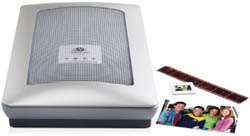 This indicator is responsible for the color perception of the scanner, namely the number of colors that the scanner recognizes and is able to process. Naturally, color depth affects the picture quality.
This indicator is responsible for the color perception of the scanner, namely the number of colors that the scanner recognizes and is able to process. Naturally, color depth affects the picture quality. You might think, the more bits in the specification, the better? Not always. Today, manufacturers provide 48 bits (this is a lot - about 35 million colors, and the picture will be an impressive size). But the final processed image is 24 bit. This is because the original media undergoes a process called image cleaning to make the output media cleaner and sharper. So look for the true bit mark in the specifications, which means the true color depth of the scanner. Although manufacturers are required to indicate the true color depth, real indicators are often kept silent.
Optical density
Optical density is a kind of range where the scanner recognizes colors and shades with extreme accuracy. The so-called scanner contrast index. Well, to be more precise, this is the scanner’s ability to distinguish between dark and light areas of an image. The need for this indicator is that it is responsible for the quality of scanning of your photographic materials, slides, film, the quality of which is difficult to determine by eye. This is where your scanner with an excellent optical density indicator comes into play. The optical density limits of scanners range from 0 (white) to 4 (black). If you are demanding about the quality of the material and are sensitive to your work, then try to choose a scanner with maximum density.Scan speed
First speed. Preview speed (in seconds). It usually doesn't take much time. Shows how quickly the scanner will pre-scan to view the image. That is, before making the final scan into a file or editor for further changes, your scanner will show you what the scanned image will look like. This is done in order to be able to correct the position of the media on the glass surface of the scanner, in the case when, say, you did not place the sheet very evenly on the surface. Very useful feature, which saves your time significantly, and the smaller it is, the better.Second speed. Minimum scanning speed (in seconds). This is what is usually indicated in the scanner's specifications. The minimum speed (minimum time) is achieved with minimum settings of the scanned image. That is, the worse the image quality you require, the lower the resolution, color and characteristics of the document (color photo, black and white photo, text with a picture, just text).
Third speed. Maximum scanning speed (in seconds). And here maximum speed(naturally in terms of scanning time) is achieved when you need to squeeze the maximum (to achieve maximum quality, resolution of your color photograph or text with a color drawing or graph).
And so, as you probably already understood, the scanning speed directly depends on your requirements for image quality and you can regulate this indicator.
Connecting a scanner
Most scanners today are connected via a USB port and are powered through it from the computer itself. In this case, no power supplies or adapters are used, which significantly saves space (does not take up sockets) to avoid tangled wires. You will simply need to connect the scanner to system unit via USB. Just pre-install necessary drivers for your operating system, and use it. Of course, this aspect does not greatly affect the scanner’s performance capabilities.To diagnose electronic systems of cars, a type of equipment such as a diagnostic scanner is used. Using this device, you can quickly carry out diagnostic work on almost all machine systems. This is possible due to the fact that the majority of new cars are equipped with electronic monitoring systems and units. Due to the presence of various monitoring sensors, information about the operating parameters and state of the components is transmitted to main computer car, and only then it can be read by a scanner.
Types
The device can be made either as a stand-alone portable element or as an entire multifunctional computer complex. Basically, an automotive diagnostic scanner can be of two types - multi-brand and dealer.
The first type of devices has one significant advantage: it is compatible with various brands of cars. Automobile manufacturers use a variety of information protocols and different connectors for connecting testing equipment in equipping their cars. Therefore, the software universal device diagnostics allows you to work with a variety of vehicles, and a set of various connection adapters eliminates the problem of connecting the scanner to systems.
The second type is devices that have the ability to check electronic systems only certain brands of cars. Devices of this type are equipped with many functionality and work as a universal diagnostic scanner. At the same time, they provide for the presence of so-called guided diagnostics. Thanks to it, the tester not only indicates a malfunction, but is also able to determine the cause and indicate an option for eliminating the error.
The functionality of scanning devices for each brand has its own limitations. For example, with a multi-brand scanner it is impossible to reprogram the electronic unit, determine the cause of the malfunction and how to eliminate it. To do this, you need to additionally use special decryption guides, and only then select possible repair measures.
Oscilloscope and motor tester
An oscilloscope is a diagnostic scanner, with which you can obtain information about the operation of certain systems in a numerical or graphical equivalent and, accordingly, compare them with standard values. More modern devices have a motor tester function.
The motor tester can work as an oscilloscope and can also measure the electrical equipment systems of the power unit. Information is read using the device’s sensors, and not from the electronic unit.
By turning on the oscilloscope mode, the motor tester can check the operation of the sensors of the control unit and determine the parameters of the signals from the unit to the execution devices. It is also possible to check the condition of electrical wiring and elements of the ignition system. 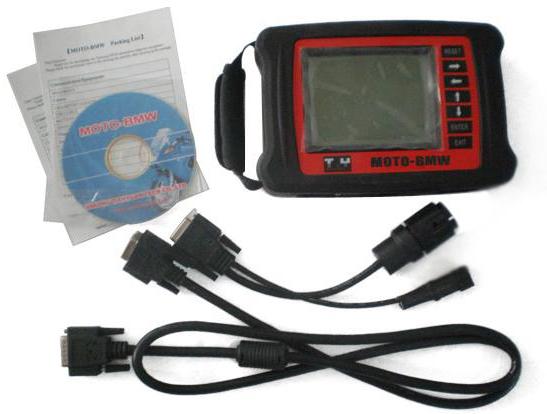 In test mode, the operation of various different systems motor. For example, measurements are made of pressure in the engine cylinders, changes in crankshaft speed when one of the cylinders is turned off, measurements of vacuum in the intake and exhaust manifolds, checking starting currents and many other operations.
In test mode, the operation of various different systems motor. For example, measurements are made of pressure in the engine cylinders, changes in crankshaft speed when one of the cylinders is turned off, measurements of vacuum in the intake and exhaust manifolds, checking starting currents and many other operations.
TO additional options The device includes the ability to test liquid temperatures, fuel pressure parameters and lubricants. Measurements are made using the device's sensors, which convert these indicators into electrical impulses.
Devices for diagnostics of certain systems
Speedometer corrector. The operation of the device is based on changing the speedometer readings. Additionally, the corrector can work as a programmer. If a car produces a larger diameter for a smaller one, or vice versa, then to eliminate the error in the readings it is necessary to make adjustments to the electronic unit.
Most correctors are equipped with additional functionality and can be used as programmers and testers for other vehicle systems - airbags, anti-theft devices.
Immobilizer. A device that protects a car from burglary and theft.  The likelihood of anti-theft program failures is just as high as in other systems. Therefore, this device is used to decode and read indicators, eliminate operational errors and update the program.
The likelihood of anti-theft program failures is just as high as in other systems. Therefore, this device is used to decode and read indicators, eliminate operational errors and update the program.
Selecting a diagnostic scanner
Selecting a car scanner is a rather serious matter. The device must meet certain standards, be of high quality and multifunctional. Below we will look at several devices that are somewhat popular.
"Scanmatic"
This device is universal. Can handle multiple protocols and provides in-depth testing of systems. Supports OBDII standards (ISO-15765-4 CAN, ISO-9141-2, SAE J1850 VPW/PWM, ISO-14230-2 KWP2000). Excellent not only for imported cars from European, American and Asian manufacturers, but also as a diagnostic scanner for VAZ.
"Ascan-10"
Refers to professional devices for diagnosing power plant systems. 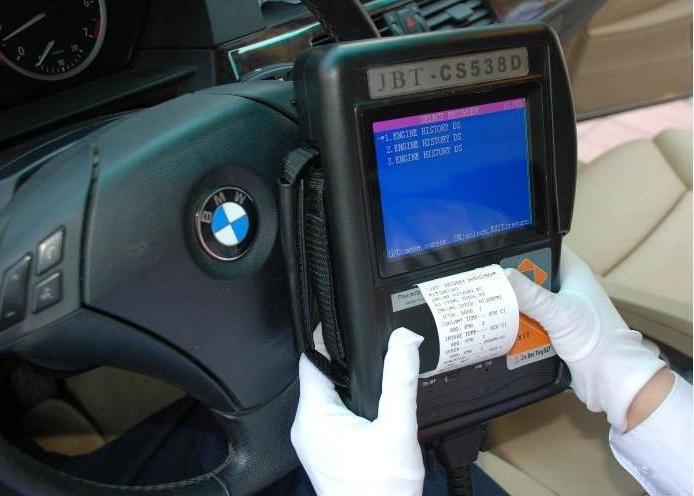 The device performs an extensive system check with the ability to reinstall software. "ASKAN-10" supports all protocols of the OBDCAN, OBDII and EOBD standards, and is intended for use in low-end imported cars.
The device performs an extensive system check with the ability to reinstall software. "ASKAN-10" supports all protocols of the OBDCAN, OBDII and EOBD standards, and is intended for use in low-end imported cars.
There are several modifications of the scanner - basic model, economy and pro. It should be noted that this diagnostic scanner is in great demand on the market due to its versatility, wide scope of application and ease of use, as well as its price category
"Scanmatic-2"
This is a new development of this brand. To the existing functions, the ability to support wireless scanning via Bluetooth has been added, as well as stable operation from USB cable already included in the basic configuration. Maintenance protocols for diesel units (Cummins, J1939; D245) have been added to the existing program.
DST-14NK1
Professional and multifunctional diagnostic scanner for VAZ, UAZ and other domestic cars. Additionally, the device is equipped with certain vehicle checking functions foreign manufacturers. It is a dealer device of the VAZ auto company. Therefore, its use is provided for its various models. Connecting the device does not cause any difficulties, since all connectors and electronic outputs comply with GOST.
MaxiSYS Pro
Wide functionality, large resource for processing and storing information, high speed.  The device is designed as a tablet with an impressive display. Due to its practical properties and extensive application, it is classified as professional equipment.
The device is designed as a tablet with an impressive display. Due to its practical properties and extensive application, it is classified as professional equipment.
The quad-core processor provides high performance, implementation of various tasks, and the ability to simultaneously test different systems. On this moment the device has no analogues. It is considered to be the best diagnostic scanner.
Once turned on, it is ready to start working within thirty seconds, while competitive devices will take more than a minute to do this. Diagnostic operations on a car are carried out several times faster than in the case of using its fellow scanner MaxiDAS, which is also considered a fairly fast scanner. The device can be applied to almost all well-known brands of car manufacturers.
There is a lot of debate about which diagnostic scanner is best. And very often motorists are at a loss when choosing one or another type and brand of device. To begin with, experts recommend deciding for what purposes a tester is needed and what responsibilities will be assigned to it. Brand is also taken into account vehicle and compatibility electronic device with her. To carry out routine diagnostic procedures, it is enough to purchase a not very expensive semi-professional device. It will allow you to determine possible malfunction or prevent its possible occurrence. 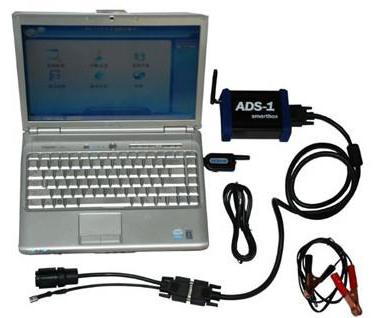 For more in-depth inspection and repair work at a professional level, it is advisable to acquire a device that is more productive and multifunctional. But it is worth considering that the price of such a device will be significant, so they are often purchased for servicing cars at qualified service stations.
For more in-depth inspection and repair work at a professional level, it is advisable to acquire a device that is more productive and multifunctional. But it is worth considering that the price of such a device will be significant, so they are often purchased for servicing cars at qualified service stations.
Test method
The process occurs in several stages, compliance with which is the key to a successful repair procedure:
- The first step is to use all the capabilities of computer diagnostics: read all the standard digital and graphic values and error codes of the system that has failed.
- The results obtained must be re-checked.
- Then you need the diagnostic scanner to view the on-board computer information in real time. This functionality is used to check the status of control elements of electronic equipment. The device screen displays signals from sensors and the values of fuel injection control systems for a certain period of time and in various engine operating modes. Next, the results obtained are compared with standard values and conclusions are drawn about the condition and operation of the devices. The best diagnostic scanners for cars can operate in multichannel oscilloscope modes, which means they receive graphic information dependence of parameters not only on time periods, but also on other sources. This testing greatly facilitates detection possible reasons damages and failures by comparing the obtained graphs with those indicated in technical map car. To carry out quality testing, it is advisable to have general concept about the functioning of car systems. Otherwise, achieving the desired result will be very difficult. Therefore, if it is not possible to carry out diagnostics yourself, it is recommended to contact technical service.
Upon completion of work, it is necessary to clear the device’s memory of fault codes and retest.  The car’s on-board computer can remember and save data on the operation of the car’s systems, and after updating the memory, the electronic unit will begin to use the readings set as standard until the parameters for each system element are adjusted in its memory. Subsequently, after several operating steps, the control unit sets the most optimal values in memory. During the period of reprogramming the control unit, the car systems may work with minor interruptions, but then everything falls into place.
The car’s on-board computer can remember and save data on the operation of the car’s systems, and after updating the memory, the electronic unit will begin to use the readings set as standard until the parameters for each system element are adjusted in its memory. Subsequently, after several operating steps, the control unit sets the most optimal values in memory. During the period of reprogramming the control unit, the car systems may work with minor interruptions, but then everything falls into place.
The word “scanners” is associated with science fiction films about aliens. It is clear that there are very few people on the planet who have not heard this term. But each of us has our own imagination. You need to understand what a scanner is. What are they? What is their purpose?
Welcome to the digital age!
More recently, the world rejoiced at scientific and technological progress, mastering audio and video recorders, film cameras and table hockey. And suddenly everything turned upside down. No one is interested in analog technology. Computers, digital cameras, mp3 players, DVD players and so on appeared. And at the crossroads of two eras, the need arose to convert the accumulated analogue information into digital. There were no problems with audio and video recordings. But what about data on paper (photos, texts, paintings)? You can use your ingenuity and use a digital camera to solve the problem. But it's so inconvenient. In such cases, you cannot do without a special device. Scanner is a new word that has appeared in the user's everyday life. Now it is on everyone's lips. The scanner is used in production, in medicine, at home, at work. You might even hear about it in the grocery store. Questions arise: “What is a scanner? Where and how is it used? 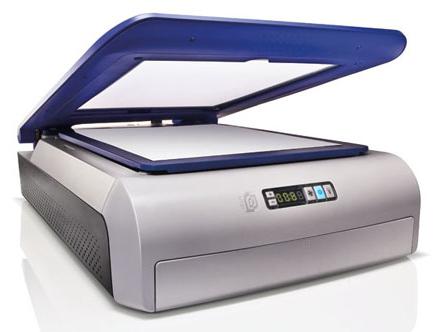
How it works?
Regardless of the scope of use, the operating principle of all scanners is similar. The device contains a sensitive matrix. It receives an image from the scanned object using special mirrors, laser, ultrasound, or directly through protective glass. The matrix is controlled by a built-in microprocessor, which processes the received information and transmits it to the computer. Most scanners do not have their own memory. Therefore, the data is transferred in parts to the computer or mobile device, in which the scanner can be built-in. Then they are collected into one picture special program. Such a transfer can be imagined in the form of shooting with a digital camera the spread of a book line by line, and then gluing the resulting frames into one picture using an editor. 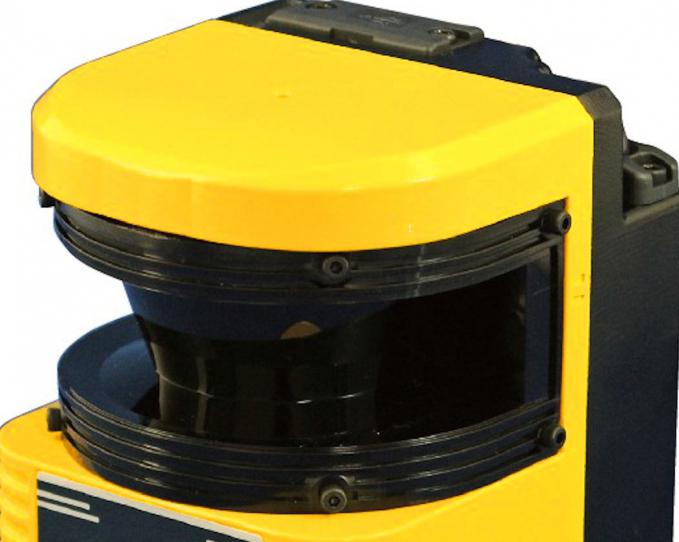
Portability comes first
A handheld scanner will be attractive to those for whom mobility comes first. Due to its light weight and size, such a device is convenient to transport. Despite its portability, the scanner copes with digitization much better than a camera. Some models run on AA batteries and have a built-in slot for memory cards. This allows it to be used as an independent device during the scanning process, and then transferred to a computer for digitization. It is very convenient for them to process small documents, for example, while on a business trip. There are hand-held models with LED backlighting and they are used to read barcodes. This type of scanner is not very popular due to its high cost. For travelers there is a special hand-held translator device. It allows you to quickly scan inscriptions and short texts, process them on site with a special program and receive a full translation into any language. Disadvantages include the difficulty of processing large volumes of texts. Moving a hand-held scanner over documents, maintaining a distance between the device and the object, at a certain speed, is quite difficult. Not to mention photographs, where every detail is important. 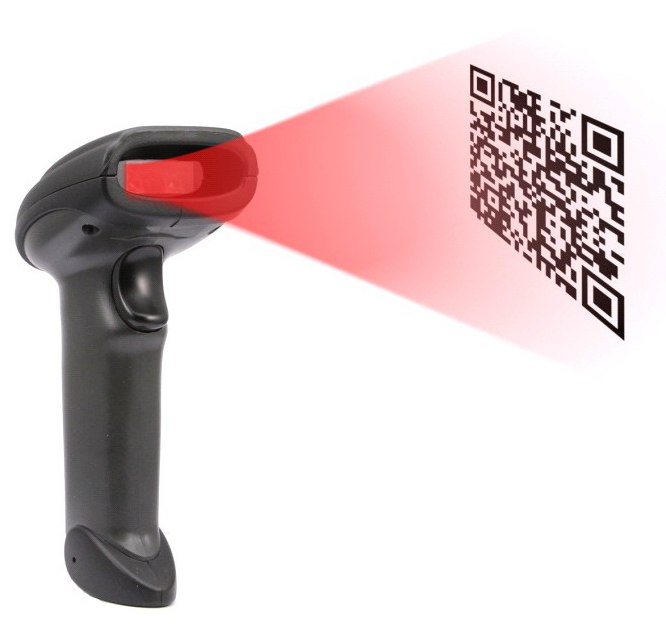
The world's most popular scanner
The flatbed scanner is the most common device in the world for digitizing information. The quality depends on the capabilities of the built-in matrix - color depth, resolution, exposure, white calibration and other settings. Manufacturers of flatbed scanners met customers halfway by creating several categories of devices. Thanks to this, the price of models for each category has changed. The cheapest device is a text scanner. It uses a low resolution sensor. It is enough to digitize text. Such a scanner can easily cope with simple graphics - newspapers, magazines and ordinary photographs in a one-to-one reproduction format. You can also find a text scanner in multifunctional devices and copiers - the matrix in these models is the cheapest. It is designed only for working with text.
For high-quality digitization of paintings and photographs, a photo scanner is required. The matrix in such a device has a high resolution and has professional attributes. Photos processed on such a device can be digitized to a huge size. This happens without loss of quality. A photo scanner designed for digitizing photographs can also handle text without any problems. But would it be advisable to buy such an expensive device for text processing?
Owners of film cameras will not be left out
Not everyone has taken the big step into the digital age. A lot of photographers, both amateurs and professionals, are not ready to spend money on expensive DSLR models. After all, the size of the matrix on any film camera is 36 x 24 mm. And only elite digital cameras, the price of which exceeds the cost of a small car, can boast of this. A slide scanner assists in digitizing the film. This device comes in two versions. In the form of additional modules for a flatbed scanner and as independent devices.
There are many craftsmen in the world who, by placing a powerful lamp above the glass of a regular flatbed scanner, manage to digitize film while holding it in their hands. 
Let's convert all the world's literature into digital form!
You need to understand what a book scanner is and why it is better than a tablet device. This type designed for processing brochures. As with the manual model, scanning is done from above, above the open book. Only the models under consideration have a higher quality matrix and allow you to read text perfectly. This device does not need to be held in your hands. It is designed in such a way as not to damage the book when turning it during the digitization process. Simplicity of the device and specialized software to process the received information, they make it possible to scan one spread of a book in less than one second.
Couldn't do it without a laser
Yes, I have laser scanner, which has found application in many industries. The principle is the same for all such models. The device has a transmitter. It sends a laser beam to a receiver, which waits for the signal to be reflected from the surface. For example, to read a barcode, a scanner sends a beam of rays onto its surface, which has a certain sequence of white and black stripes. There is one beam for each strip. Next is physics. The black stripe absorbs the beam, the white stripe reflects it. The scanner, through a receiver, receives a sequence of reflected and absorbed rays and transmits the information to the base.
A laser scanner is used in geodesy and cartography to scan buildings, quarries, gorges, mountains and other surfaces. The device is able, based on the quality of the reflected signal, to determine the distance between it and the scanning object. The principle of operation is simple. The device is given the scanning area and its measurement density. The result will be data in the form of many dots of different shades, indicating a certain distance.
Application of a scanner in medicine
Most parents know exactly the sex of the child even before his birth. Using an ultrasound scanner, the doctor can determine the physical development of the baby. And, of course, it is used to prevent the development of fetal diseases and prescribe treatment. It is worth considering in more detail what a scanner is in medicine. Thanks to the use of ultrasound, which does not cause harm to a living organism, it is possible to diagnose many internal human organs. The devices in question allow doctors to warn patients about the initial stage of the disease, prescribe treatment and save millions of lives. Diagnostic equipment using ultrasound is available to everyone. Experts recommend being examined at least once a year to prevent the development of diseases. 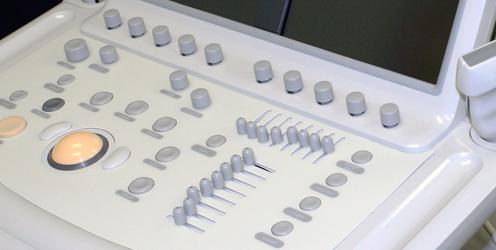
Safety comes first!
About scanners information security everyone started talking at the end of the 20th century, when scammers and virus developers took advantage of the vulnerabilities of networks, servers and operating programs on users’ computers, gained unhindered access to other people’s data. An antivirus is not enough here. And there is no universal program that can protect against hacking. In such cases, a web scanner is useful, which, simulating a hack, will go through all ports, services and applications of a computer, website or server and issue a summary report on the vulnerability. And then the user eliminates the errors found step by step. To effectively search for security problems, it is recommended to use several web scanners, since they have different reading modules and functionality. 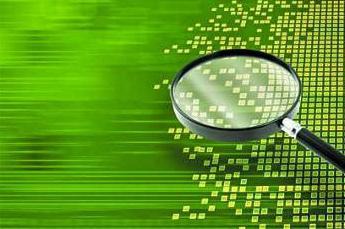
Technologies of the 21st century - a step into the future
What is a scanner of the future? And these are not just dreams. This includes a 3D scanner. Such a device already exists. But its price is not yet affordable to a simple user. It is used for the production of three-dimensional parts and prototypes in factories, as well as for the creation of 3D models in computer animation. Scanning accuracy is measured in microns, which allows you to accurately digitize any object.
Biometric scanners are becoming popular quite quickly. For example, a fingerprint scanner can be found on expensive laptops. And reading the pattern of the retina is used in government agencies of the executive branch.
Not only office work requires the ability to use various devices connected to a computer. These include, scanner, etc. These skills are also needed in Everyday life any mother, since they very often help to complete homework with the child or get the necessary drawing or text from a book.
But even if you have a computer and a scanner, this does not mean that you will be able to work with them right away. Of course, when purchasing this office equipment, you will receive instructions for using the scanner. But it will be difficult for a person who does not have experience in operating such devices to master it on their own. Therefore, for those who doubt their abilities, in this article we will highlight how to use the scanner correctly.
First of all, you need to figure out how to turn it on and configure it to work.
How to connect a scanner to a computer?
It is quite natural that it must be connected to both the power supply and the computer. After all, the scanner reads a two-dimensional image and presents it in electronic form, so to see the result, you need a PC monitor.
To connect the scanner to a computer, insert its USB port into one of the sockets on the rear panel of the power supply. After this, we turn on the connected devices and proceed to installing drivers. To do this, just insert installation disk and follow the prompts that appear. If you installed everything correctly, your smart car will see the new device. You can tell this by the presence of a scanner icon on the taskbar.
Based on why you need a scanner, you should also install programs on your computer through which you will work with it: scan and recognize text - ABBYY FineReader, with pictures - Adobe Photoshop or XnView. Typically, programs with a scanning function are available on the driver disk for the device.
Working with the scanner
Let's start scanning.
- Raise the lid and place the paper on the glass with the design (text) down.
- We launch the scanning program or press the button on the device itself.
- Using lines, we edit the size of the preliminary image that appears on your computer screen. You can also change its resolution (the higher, the clearer the result will be) and color scheme, or even make it black and white.
- IN open window program, we press the “scan” button, sometimes “start” or “accept”, and wait until the scanner beam passes in one direction and back. The larger the original drawing and higher set resolution, the slower the read head will move. So be patient.
- When an already digitized version of your paper original appears on the screen, you should save it. To do this, select “File”, and in the window that then opens, click “Save As”. We name the file with the scan result as we need and select the folder where it should be saved.
When using the ABBYY FineReader program to digitize a document, just click “Scan&Read” and all steps will be performed automatically.
 Scanner Precautions
Scanner Precautions
Since the surface on which the paper original is placed is glass, it should be handled very carefully:
- Don't press too hard. Even if you need to scan a book spread that does not fit tightly to the surface of the device.
- Avoid scratches and stains. They will reduce the quality of the resulting image. To avoid this, do not place dirty papers on the glass. And if this does happen, then you cannot use powder products when cleaning the surface.
